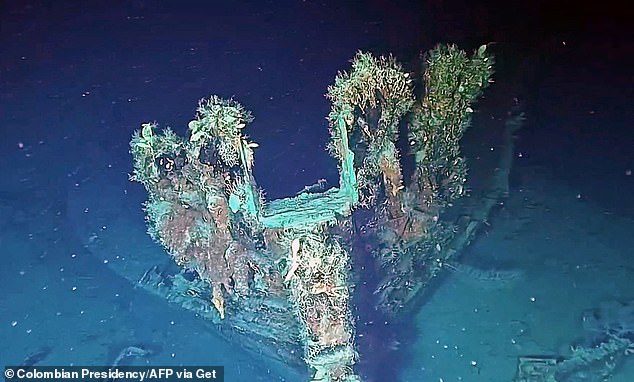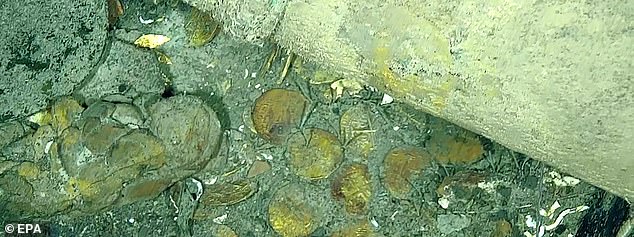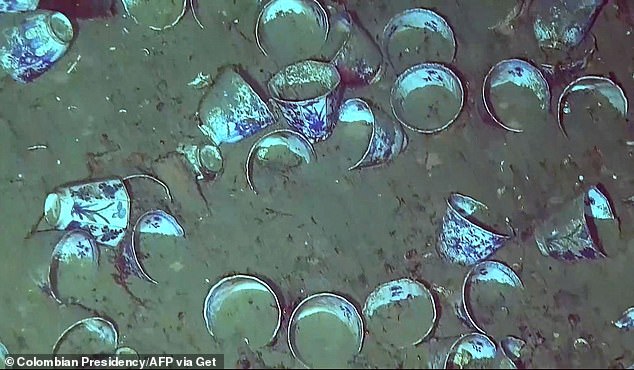‘Holy grail’ shipwreck with billions of gold and jewels remains at the bottom of ocean – but officials have just made it far harder for anyone to claim the treasure
The ‘holy grail’ of shipwrecks still lies at the bottom of the ocean, littered with billions of gold and jewels – but the Colombian government has only made it harder to claim the treasure.
The legendary San Jose galleon sank off the Caribbean coast more than three centuries ago, taking with it gold, silver and emeralds, believed to be worth $20 billion at today’s value.
On Wednesday, Colombia declared a “protected archaeological area” around the site where the ship sank off the Colombian port of Cartagena after its powder magazines exploded during a skirmish with the British in 1708.
The Ministry of Culture said the designation “guarantees the protection of heritage” through the “long-term conservation of the ship and the development of research, conservation and appreciation activities.”
At the time of the sinking, the San Jose was owned by the Spanish crown – there were 600 sailors on board, all but eleven of whom went down with the ship.
The legendary San Jose galleon (depicted in this painting) sank off the Caribbean coast more than three centuries ago, taking with it gold, silver and emeralds, believed to be worth $20 billion in today’s currency

The San Jose was a 62-gun galleon that sank on June 8, 1708, with 600 people on board
The boat, dubbed the ‘Holy Grail’ of shipwrecks because of its abundant treasures, was on its way back from the New World to the court of King Philip V of Spain when it plunged to the bottom of the ocean.
The 62-gun galleon was sailing from Portobelo, Panama at the head of a treasure fleet of fourteen merchant ships and three Spanish warships when it encountered the British squadron near Barú.
In 2015, the Colombian government announced that a team of naval divers had discovered the legendary ship in nearly 3,000 feet of water.
Colombia announced the discovery of the San Jose that same year, but by then it had already attracted the attention of adventurers.
Last year, another team brought back breathtaking images of its perfectly preserved cargo.
The Colombian government previously claimed the ship would be lifted before President Gustavo Petro ends his term in 2026.
However, a major fight is brewing over who owns the ship, with an American company claiming to have discovered the ship and claiming a share of the treasure.
The Spanish government and an indigenous group also claim ownership of the shipwreck.
US research firm Glocca Morra claims it found the San Jose in 1981 and handed over the coordinates to the Colombians on the condition that it would receive half the fortune once the ship was recovered.

Gold coins were also picked up on the video released by the Colombian government

An intact Chinese set of dishes and other tableware were among the ship’s treasures
But the company’s claim was refuted in 2015 by Colombia’s then president, Juan Manuel Santos, who said the navy had found the boat in a different location on the seabed.
Glocca Morra, now called Sea Search Armada, is suing for half of the treasure — about $10 billion according to current estimates — under the U.S.-Colombia trade facilitation deal, according to Bloomberg.
But Colombian Culture Minister Juan David Correa said the government team had visited Sea Search Armada coordinates and found no trace of the San Jose.
Complicating matters are the competing claims of the Spanish – whose navy owned the ship – and the indigenous Bolivian nation of Qhara Qhara, who say the population was forced to mine the gold and jewels so that the treasures could reach their be owned.
Meanwhile, Colombia has hailed the find as a huge historical and cultural achievement.
Correa told Bloomberg: “This is one of the priorities for the Petro government. The president has told us to pick up the pace.”
